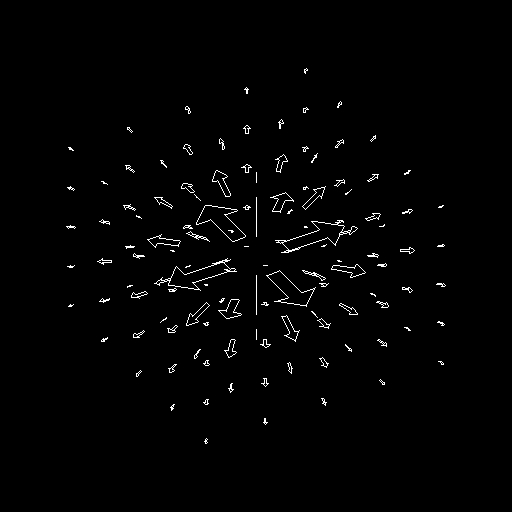The functions we have discussed so far are all scalar functions since they return a singe, scalar value. However, many scientific and engineering applications require the use of vector valued functions which return, instead of a scalar, a vector. Often, they are called vector fields. For example, the velocity field of a fluid or the electro-magnetic field of a distribution of charges are both vector fields. The idea of a scalar function is that every point in the domain is associated to a real number in the range. In the case of a vector field, each point in the domain (usually three dimensional space) is associated to a three-dimensional vector. This can be done in any number of dimensions, but it is easiest to picture in two dimensions.
Usually we denote a vector valued function in two ways. First, we write
the name of the function in capital letters. Second, we put a vector arrow
on top of the name of the function. Thus, ![]() is a vector
valued function, while f(x,y) is not.
is a vector
valued function, while f(x,y) is not.
For example, the vector field ![]() associates the vector
associates the vector ![]() to every point (x,y) in the
plane. At the point (0,0), the vector field has the value
to every point (x,y) in the
plane. At the point (0,0), the vector field has the value ![]() . At
(1,-1) the vector field is
. At
(1,-1) the vector field is ![]() , and so forth. A
graphical representation is more helpful.
, and so forth. A
graphical representation is more helpful.

We can have vector fields in three space, although these are more difficult to draw than even a surface plot of a function.
One other notation that you will frequently encounter involves the position
vector, ![]() , of a point (x,y,z). The position vector is
, of a point (x,y,z). The position vector is ![]() . The magnitude of this vector is denoted
r and has the value
. The magnitude of this vector is denoted
r and has the value ![]() .Usually, we denote vector fields as
.Usually, we denote vector fields as ![]() rather than
rather than
![]() . For example, the vector field
. For example, the vector field ![]() has magnitude
has magnitude
![]()
When it comes to three dimensional vector fields, the two most important details for getting a handle on what is happening are the magnitude and direction of the field. Magnitude is easy to compute (as shown above.) Direction is usually a bit harder to ascertain. As is clear(?) from the following graph of the vector field above.

For a second example, consider the vector field ![]() . The magnitude of this field is equal to 2 everywhere. Thus,
it is constant. It's direction is antiparallel to the position vector, so
it always points toward the origin. Note however that the vector field is
not defined at the origin (as in the previous example) since, at (0,0,0)
the magnitude of the position vector is which means the vector field
would have the value of
. The magnitude of this field is equal to 2 everywhere. Thus,
it is constant. It's direction is antiparallel to the position vector, so
it always points toward the origin. Note however that the vector field is
not defined at the origin (as in the previous example) since, at (0,0,0)
the magnitude of the position vector is which means the vector field
would have the value of ![]() which is undefined.
which is undefined.